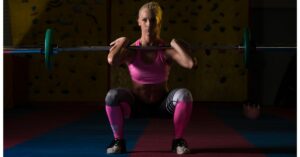Hey there, fitness enthusiasts! If you’ve ever found yourself wondering why that seemingly modest 45kg front squat feels like an insurmountable mountain to conquer, you’re not alone.
It’s a question many of us have asked at some point in our weightlifting journey.
In this blog post, we’re going to dive deep into the reasons behind this struggle, offering insights and practical tips to help you tackle the 45kg front squat with confidence.
So, let’s lace up our lifting shoes and embark on this journey of discovery together!
Exploring the reason Why you Struggle at the Bottom with a 45kg Front Squat.
Struggling with a 45kg front squat can be attributed to various factors, including your strength, technique, and mobility.
Let’s break down some possible reasons for your difficulty with this weight:
- Strength Level: The most straightforward explanation might be that your leg and core strength is not yet sufficient to handle a 45kg front squat. This could be due to your training history, genetics, or simply needing more time to build strength in those muscle groups.
- Technique Issues:
- Proper Form: Front squats require specific form, including a straight back, an upright torso, and a stable core. If your technique is off, it can make lifting the weight more challenging.
- Bar Placement: The bar should rest on your shoulders, not your neck, and your elbows should be high. Incorrect bar placement can throw off your balance and make the lift harder.
- Mobility and Flexibility:
- Ankle Mobility: Insufficient ankle mobility can affect your ability to keep your heels down during the squat, leading to balance problems and making the lift harder.
- Hip Mobility: Limited hip mobility can affect your depth and form in the squat.
- Thoracic Mobility: Adequate mobility in your upper back is necessary to maintain an upright posture during the front squat.
- Core Strength: A strong core is crucial for stability during front squats. If your core is weak, you may struggle to maintain the correct position throughout the lift.
- Inadequate Warm-Up: Failing to warm up properly can impact your performance. Ensure you do dynamic stretches and warm-up sets to prepare your muscles and joints.
- Progression: It’s essential to progress gradually in weight. Jumping from a significantly lower weight to 45kg can be a big leap for some people. Gradually increasing the weight and allowing your body to adapt can be more effective.
- Fatigue or Overtraining: If you’re not adequately recovered from previous workouts or have been overtraining, your strength levels might temporarily drop.
- Psychological Factors: Confidence and mental focus play a significant role in lifting heavy weights. If you doubt your ability or are anxious about the lift, it can affect your performance.

To improve your front squat, consider addressing these factors:
- Consult a qualified coach or trainer to assess your form and technique.
- Incorporate mobility exercises into your routine to improve flexibility where needed.
- Work on strengthening your core and leg muscles with targeted exercises.
- Ensure you have a proper warm-up and recovery routine.
- Consider periodizing your training to gradually increase the weight.
- Stay mentally focused and confident during your lifts.
Remember that everyone progresses at their own pace, and it’s essential to listen to your body to avoid injury. If you’re consistently struggling or experiencing pain, consult a fitness professional for personalized guidance.
Further Explanations.
Let’s dive deeper and elaborate further on all the points mentioned.
Firstly though let’s delve deeper into the strength level and technique issues that can affect your ability to perform a 45kg front squat:
Strength Level:
Leg Strength: Leg strength is pivotal for any type of squat, including the front squat. The quadriceps, hamstrings, and glutes are the primary muscles engaged during this exercise. If your leg muscles are underdeveloped, it will be challenging to lift heavier weights. Possible factors affecting your leg strength include:
Training History: If you’re relatively new to strength training, your leg muscles may not have had enough time to adapt and grow.
Genetics: Genetics play a role in your muscular development. Some individuals naturally have greater potential for muscle growth in their legs, while others may need more time and effort to build strength.
Training Consistency: Consistency in your workouts is crucial. If you haven’t been training your legs regularly or have been inconsistent with your workouts, it can impact your leg strength.
Core Strength: Your core muscles are essential for stabilizing your spine and maintaining an upright posture during the front squat. A weak core can lead to poor form and make the lift more challenging. Core strength can be improved through exercises like planks, Russian twists, and leg raises.
Technique Issues:
Proper Form: Achieving the correct form during a front squat is vital for safety and effectiveness. Here’s a breakdown of key form elements:
Straight Back: Keeping your back straight helps distribute the load evenly across your spine and reduces the risk of injury. Rounding your back can strain the lower back and compromise your form.
Upright Torso: An upright torso ensures that the weight is distributed over your center of gravity. Leaning too far forward can cause you to lose balance and make it harder to lift the weight.
Stable Core: A stable core helps maintain a strong and secure foundation. Without core stability, you might struggle to control the movement and may even risk injury.
Bar Placement: Proper bar placement is essential to maintain balance and prevent discomfort or injury. Here’s how to ensure correct bar placement:
Resting on Shoulders, Not Neck: The bar should sit comfortably on your anterior deltoids (the front part of your shoulders) and upper chest. It should never rest on your neck, as this can cause pain and potential injury.
High Elbows: Keep your elbows pointing forward and upward. This position helps create a “shelf” for the bar to rest on and promotes a more stable front squat.
To address these issues, consider working with a knowledgeable coach or trainer who can provide hands-on guidance and corrections. Additionally, gradually increasing the weight and focusing on proper form during lighter sets can help you build the necessary strength and technique for a successful 45kg front squat.
let’s dive deeper into the importance of mobility, flexibility, and core strength for front squats:
Ankle Mobility:
Impact on Front Squat: Ankle mobility refers to the range of motion in your ankle joint. Inadequate ankle mobility can be a significant hindrance during front squats because it affects your ability to maintain a stable and balanced position. Specifically, it can impact your ability to keep your heels down on the ground, which is crucial for maintaining balance and generating power during the squat.
Solutions:
Stretching and Mobility Exercises: Incorporate ankle mobility exercises and stretches into your warm-up routine. These exercises can include calf stretches, ankle circles, and mobility drills to improve your ankle’s flexibility and range of motion.
Proper Footwear: Wearing weightlifting shoes with an elevated heel can help compensate for limited ankle mobility by allowing you to maintain a more upright posture during the squat.
Hip Mobility:
Impact on Front Squat: Hip mobility is essential for achieving proper depth and form in the front squat. Limited hip mobility can prevent you from descending into a deep squat position comfortably, which may result in incomplete squats or compensation through poor form.
Solutions:
Hip Flexor Stretches: Stretching the hip flexors and quadriceps can improve hip mobility. Exercises like lunges, pigeon stretches, and butterfly stretches can be beneficial.
Dynamic Warm-Up: Include dynamic warm-up exercises that specifically target hip mobility, such as leg swings and hip circles.
Thoracic Mobility:
Impact on Front Squat: Thoracic mobility is crucial for maintaining an upright posture during the front squat. If your upper back is stiff or lacks mobility, you may struggle to keep your chest up and elbows high, which can compromise your form and balance.
Solutions:
Foam Rolling: Using a foam roller or mobility ball on your upper back can help release tension and improve thoracic mobility.
Mobility Drills: Incorporate mobility drills that focus on thoracic extension and rotation into your warm-up routine. These can include exercises like wall slides and cat-cow stretches.
Core Strength:
Impact on Front Squat: A strong core is essential for stability and maintaining the correct position throughout the front squat. Without core strength, you may have difficulty controlling the weight, keeping an upright posture, and preventing your lower back from rounding.

Solutions:
Core-Specific Exercises: Include core-strengthening exercises such as planks, Russian twists, leg raises, and anti-rotation exercises in your training program.
Stability Training: Utilize stability exercises on unstable surfaces like stability balls or BOSU balls to challenge and strengthen your core further.
Addressing these mobility, flexibility, and core strength issues through targeted exercises and stretches can significantly improve your front squat performance. Incorporating these elements into your regular training routine will not only make the lift easier but also reduce the risk of injury and allow you to progress in weightlifting more effectively.
let’s explore the importance of a proper warm-up and gradual progression in weightlifting:
Inadequate Warm-Up:
Impact on Performance: Failing to warm up adequately can have a negative impact on your performance during a front squat. When you start a workout with cold muscles and joints, it can lead to reduced flexibility, decreased strength, and an increased risk of injury.
Warm-Up Components:
Dynamic Stretches: Dynamic stretching involves active movements that mimic the exercise you’re about to perform. In the case of a front squat, dynamic stretches for the lower body can include leg swings, hip circles, and bodyweight squats.
Warm-Up Sets: Gradually increase the weight with warm-up sets before attempting your working weight. Start with lighter weights and perform a few sets with progressively heavier loads to prepare your muscles and nervous system for the heavier lift.
Benefits:
Increased Blood Flow: Warming up increases blood flow to your muscles, which helps deliver oxygen and nutrients to your working muscles.
Improved Flexibility: Dynamic stretching can enhance your range of motion and flexibility, making it easier to perform exercises like the front squat with proper form.
Enhanced Muscle Activation: Warm-up sets prepare your muscles and central nervous system for the demands of heavier lifting.
Progression:
Gradual Progression: Progressing gradually in weightlifting is crucial for several reasons:
Safety:
Rapidly increasing weight without sufficient strength and technique can lead to injuries. Gradual progression reduces this risk.
Adaptation: Your body needs time to adapt to increasing loads. Incremental increases allow your muscles, tendons, and ligaments to adapt and become stronger over time.
Consistency: Consistent, incremental progress is more sustainable and helps you avoid plateaus.
How to Progress:
Set Goals: Determine your short-term and long-term strength goals. These could include specific weightlifting milestones you want to achieve.
Use Periodization:
Consider using a periodization program, which involves planned cycles of training with varying intensities and volumes to optimize progress.
Track Your Progress:
Keep a training log to record your lifts, sets, and repetitions. This helps you monitor your progress and make informed decisions about when to increase the weight.
Listen to Your Body:
Pay attention to how your body responds to increasing weights. If you experience pain or form breakdown, it’s essential to address these issues before adding more weight.
By warming up properly and implementing a gradual progression plan in your weightlifting routine, you can enhance your performance, reduce the risk of injury, and achieve your strength and fitness goals more effectively over time.
let’s delve into the impact of fatigue or overtraining as well as psychological factors on your ability to perform a 45kg front squat:
Fatigue or Overtraining:
Fatigue:
Fatigue occurs when your body is not adequately recovered from previous workouts or when you haven’t given your muscles and central nervous system enough time to recuperate.
This can manifest in various ways, including decreased strength, endurance, and motivation.
Overtraining:
Overtraining is a more severe form of fatigue that occurs when you consistently push your body beyond its ability to recover.
It can lead to a range of physical and psychological symptoms, including reduced performance, chronic fatigue, and an increased risk of injury.
Impact on Front Squat:
Reduced Strength: Both fatigue and overtraining can lead to temporary reductions in strength. Your muscles may not be able to generate the same force as when you’re fully rested and recovered.
Poor Concentration: Fatigue can affect your ability to concentrate and maintain focus during the lift, which is essential for proper form and technique.
Increased Perceived Effort: You may perceive the 45kg front squat as more challenging than it would be under normal conditions due to the added strain from fatigue.
Solutions:
Adequate Rest: Ensure you’re allowing enough time for recovery between intense workouts, especially if you’re targeting the same muscle groups.
Sleep and Nutrition: Prioritize quality sleep and proper nutrition to support recovery and energy levels.
Listen to Your Body: Pay attention to signs of fatigue or overtraining, such as persistent soreness, decreased motivation, and reduced performance. Adjust your training schedule and intensity accordingly.
Psychological Factors:
Confidence:
Confidence plays a significant role in lifting heavy weights. If you doubt your ability to perform a 45kg front squat, it can create mental barriers that affect your physical performance.
Mental Focus:
Maintaining mental focus and concentration is crucial during challenging lifts. Anxiety, distractions, or lack of focus can lead to errors in technique and form.
Impact on Front Squat:
Lack of Confidence: If you don’t believe you can successfully lift the weight, you may psych yourself out and struggle with the lift, even if you have the physical capacity to do it.
Anxiety and Nervousness: Anxiety or nervousness about the lift can lead to increased muscle tension and reduced fluidity in your movements.
Loss of Focus: Losing focus during the lift can lead to form breakdown, balance issues, and even safety concerns.
Solutions:
Visualization: Visualize yourself successfully completing the lift before you attempt it. Positive visualization can boost your confidence and mental readiness.
Relaxation Techniques: Practice relaxation techniques such as deep breathing or mindfulness to calm your nerves before the lift.
Positive Self-Talk: Replace negative self-talk with positive affirmations and reminders of your past successes in lifting.
Addressing psychological factors is crucial for overcoming mental barriers and optimizing your performance in weightlifting. Building confidence and maintaining mental focus can make a significant difference in your ability to successfully front squat 45kg or any other challenging weight.
A tabular on this topic here.
Here’s a tabular breakdown of the reasons why you might struggle at the bottom with a 45kg front squat:
| Factors | Explanation |
|---|---|
| Strength Level | Your leg and core strength may not be sufficient to lift 45kg due to various factors such as training history, genetics, or the need for more time to build strength. |
| Technique Issues | Problems with proper form and bar placement can impact your balance and make lifting the weight more challenging. |
| Mobility and Flexibility | Issues with ankle, hip, and thoracic mobility can affect your depth, form, and balance during the squat. Inadequate core strength can lead to instability. |
| Inadequate Warm-Up | Failing to warm up properly can reduce flexibility, strength, and performance, affecting your ability to lift the weight. |
| Progression | Jumping from a significantly lower weight to 45kg can be challenging; gradual progression helps your body adapt to heavier weights effectively. |
| Fatigue or Overtraining | Lack of adequate recovery or overtraining can lead to temporary strength reductions and poor concentration. |
| Psychological Factors | Confidence and mental focus are crucial; doubts, anxiety, or distractions can affect your performance negatively. |
Understanding and addressing these factors can help you improve your front squat performance and overcome difficulties at the bottom position with a 45kg load.
Conclusion.
In conclusion, struggling with a 45kg front squat can be attributed to a combination of factors, including strength, technique, mobility, warm-up, progression, fatigue, and psychological factors.
It’s essential to address these aspects systematically to enhance your front squat performance.
Building strength, improving technique, ensuring mobility, and paying attention to mental factors are key elements in overcoming these challenges and progressing in your weightlifting journey.

Hey there, it’s Mike Rrsq, the Editor-in-Chief over at Jsquat.com, and I’m absolutely obsessed with all things squat fitness! I’ve been lucky enough to get some serious recognition for my work in this field. With a solid background in the fitness and wellness industry, I’ve been there right from the get-go, helping shape this website into what it is today.
You see, I’m not just the boss around here; I’m also a passionate contributor. I love sharing my insights through my articles, and trust me, they’re not your run-of-the-mill stuff. Each piece I write is a labor of love, filled with my expertise and real-world experience in the fitness universe. So, if you’re into fitness and looking for some inspiration, you’re in the right place!

